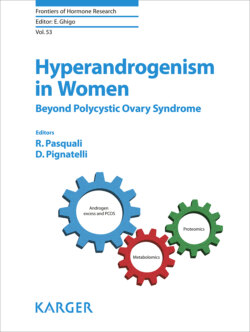Читать книгу Hyperandrogenism in Women - Группа авторов - Страница 30
Preclinical Studies
ОглавлениеTissue mass depends both on number and on dimension of cells; an increase can be therefore due to hyperplasia or hypertrophy. Adipocyte and myocyte share the pluripotent mesenchymal cell as common precursor. Some experiments in rats and mice and cell cultures from men and women showed that their differentiation is influenced by androgens, with T and DHT inhibiting the adipogenic lineage through peroxisome proliferator-activated receptor gamma and CAAT/enhancer-binding protein alpha, while promoting the myogenic lineage through Wnt signaling [29–31]. As to what concerns size, T increases hormone-sensitive lipase expression while reducing lipoprotein lipase in preadipocytes and adipocytes, thus enhancing catecholamine-stimulated lipolysis and limiting fatty acids uptake and esterification to triglycerides [19, 25, 32, 33]. In myocyte, it stimulates myonuclei and protein synthesis, thus leading to hypertrophy and both type 1 and 2 muscle fibres [34].
It is worth noting that a large variability of androgens effect has been reported both in preclinical and clinical studies. Epididymal and retroperitoneal adipose tissue of rats are commonly analyzed as model for human VAT, while the inguinal fat is considered a model for human SAT [35]. In cell cultures of preadipocytes of male rats, T and DHT decrease both epididymal and subcutaneous differentiation, the former being more responsive [29, 30, 36]. In male rats, castration has been associated both to inhibition of epididymal preadipocytes differentiation and increase of perirenal ones [30, 37]. In female ovariectomized rats, T reduced the number of adipocyte in inguinal fat depots more than in retroperitoneal, while reducing the percentage of preadipocytes only in the inguinal region [38]. Although these differences have been partially attributable to sex and type of adipose tissue, a clear inhibitory effect of androgens on lipolysis and adipogenesis in female rats is still to be demonstrated [30].
In vitro studies conducted in adipocytes obtained from transsexuals, before and after cross-sex hormonal therapy owing to the gender reassignment, confirmed results found in animal studies: visceral and subcutaneous adipocytes of male-to-female transsexuals (MtoF) after combined antiandrogen and oestrogens showed a significant reduction in basal lipolytic activity along with an increase in cells size, whereas diametrically opposite results were found in the adipocytes coming from female-to-male transsexuals (FtoM) after T supplementation [39].
